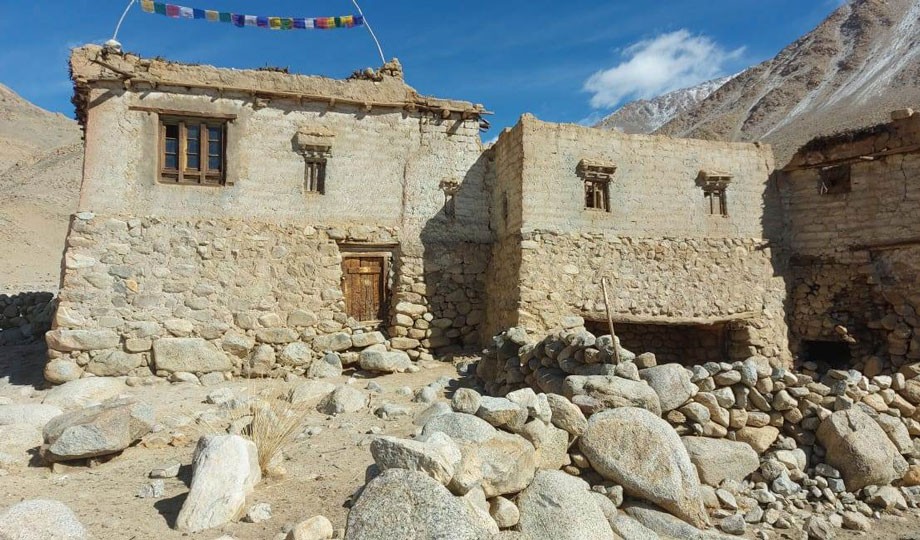Kulum Water Crisis: A wake-up call for Ladakh Residents forced to migrate due to water scarcity

Kulum, situated 50 km north of Leh town, was once a thriving village with its inhabitants dependent on agriculture and livestock rearing for their livelihood. Things changed drastically post 2010 due to a shortage of drinking water. The villagers were forced to migrate to Upshi, the nearby village, as the worsening water crisis aggravated. The once-bustling village with 11 families is now only left with four families.
Since agriculture is no longer a viable option for the villagers, they either work as daily wagers or have set up shops or tea stalls at Upshi to put bread on their tables.
Kunzang Namgyal, a resident of Kulum, shared: “We are dependent on spring water for irrigation, drinking, and other purposes. We have been facing an acute water crisis since 2010 due to the drying up of water streams and springs. We were forced to abandon our ancestral agricultural lands as there is no water available for irrigation purpose. We shifted to nearby villages for our livelihood.”
Residents of Kulum village were dependent on spring water and snowfall in winters to meet their water demands due to a lack of other sources such as glacier-melt water. Less snowfall and drying up of springs forced the villagers to move from an agrarian-based economy to an industrial-based economy.
Owing to less snowfall and drying up of water springs have not only forced the villagers to give up the agrarian-based economy but rendered them to arrange water for day-to-day needs. It could be aptly said that the village has become a victim of climate change- a concern often raised on various platforms, but hardly any action has been taken to tackle the issue.
Phuntsog Dolma, an elderly woman of the village, said, “It’s sad to see the village turning into a ghost town. We are facing water scarcity, but we never thought that things would go so bad that we have to leave everything and settle down somewhere else. It’s disheartening to see everyone moving far away. Now, only the elderly people are left behind in the village.”
“We are not taking care of the environment and are constantly exploiting it for our own selfish needs. It seems we are paying a heavy price for it,” she added.
Even as the issue of mass migration due to shortage of water is real in Ladakh, there are institutions such as the Himalayan Institute of Alternatives Ladakh (HIAL) providing a ray of hope for residents of Kulum. Attempts are being made to rehabilitate the village by solving the water crisis through artificial glaciers.
The HIAL team with help from the villagers are building three artificial glaciers, famously
known as ‘Ice stupa’.
Urgain Chorol, a resident of the village also shared the issues and said, “ It’s disheartening to leave everything and start afresh, finding a new source of living, etc, is never easy.”
Mass migration due to the water crisis is real in Ladakh and amidst this crisis, the Himalayan Institute of Alternatives Ladakh gave a ray of hope for Kulum. An attempt is being made to rehabilitate the village by solving the water crisis issue through an artificial glacier.
Three artificial glaciers are famously known as ‘Ice stupa’ are built by the HIAL team along with the help of a villager.
The people of Kulum are very hopeful that the initiative will solve their water issue.
Urgain Chorol exudes confidence and is optimistic that the initiative would soon solve the water issues. “We expect the water from the glacier to meet the requirements of the people during the sowing season. It will help us to cultivate our land that was left abandoned,” she said.
She shared that villagers would return to the village if these projects are successful.
Ramon Magsaysay awardee, Sonam Wangchuk, said, “The idea of coming up with artificial glaciers to solve the water crisis is crucial because the village has turned into a ghost town. The idea behind this is to rehabilitate the village, and also inspire similar villages facing the same issue and crisis.”
“The success story of the village will attract tourists from different parts of the world and boost the economy of the village,” he added.
Sonam Wangchuk while speaking on meeting the requirements of water for people through the artificial glacier, shared that alternative methods and technologies such as drip/sprinkle irrigation and greenhouse would be explored to make the best use of water.
The story and plight of residents of Kulum village is a wake-up call to many other such villages of Ladakh facing water scarcity due to the effects of climate change. Now the time has come to rethink, plan and act wisely for a better and sustainable future.





